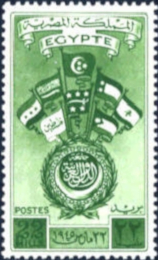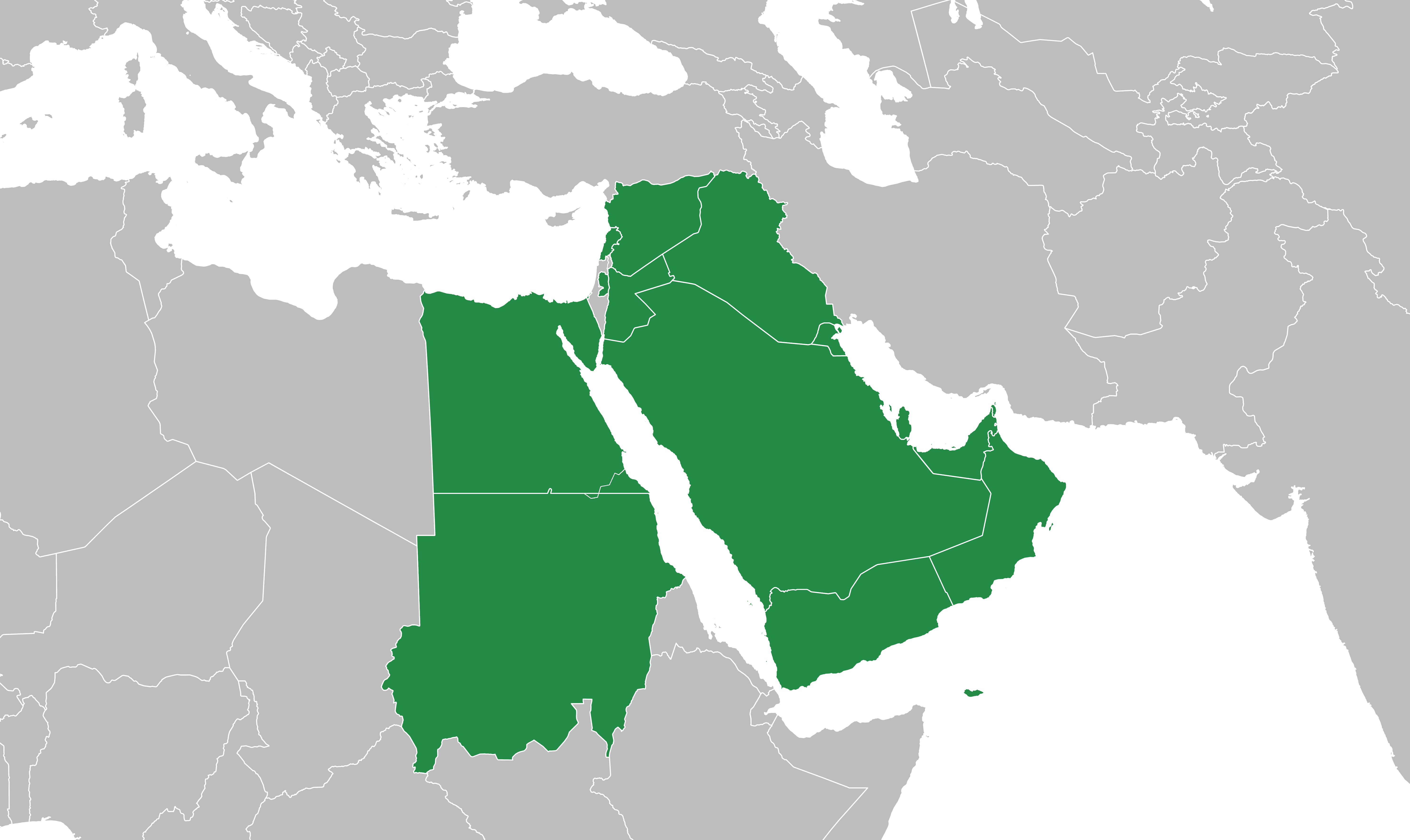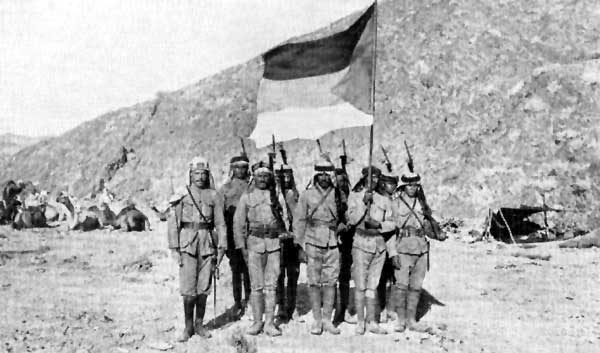|
Palestinian Flag
The flag of Palestine ( ar, علم فلسطين) is a tricolor of three equal horizontal stripes (black, white, and green from top to bottom) overlaid by a red triangle issuing from the hoist. This flag is derived from the Pan-Arab colors and is used to represent the State of Palestine and the Palestinian people. It was first adopted on 28 May 1964 by the Palestinian Liberation Organization. The flag day is celebrated on 30 September. The flag is almost identical to that of the extinct Hashemite Kingdom of Hejaz and to that of Syria's Ba'ath Party (both use a 2:3 ratio as opposed to Palestine's 1:2), as well as the short-lived Arab Federation of Iraq and Jordan (which had an equilateral triangle at the hoist). It is also very similar to the Flag of Jordan and to the Flag of Western Sahara, all of which draw their inspiration from the Arab Revolt against Ottoman rule (1916–1918). The flag of the Arab Revolt had the same graphic form, but the colours were arranged d ... [...More Info...] [...Related Items...] OR: [Wikipedia] [Google] [Baidu] |
Palestinian Liberation Organization
The Palestine Liberation Organization (PLO; ar, منظمة التحرير الفلسطينية, ') is a Palestinian nationalist political and militant organization founded in 1964 with the initial purpose of establishing Arab unity and statehood over the territory of former Mandatory Palestine, in opposition to the State of Israel. In 1993, alongside the Oslo I Accord, the PLO's aspiration for Arab statehood was revised to be specifically for the Palestinian territories under an Israeli occupation since the 1967 Arab–Israeli War. It is headquartered in the city of Al-Bireh in the West Bank, and is recognized as the sole legitimate representative of the Palestinian people by over 100 countries that it has diplomatic relations with.Madiha Rashid Al-Madfai, ''Jordan, the United States and the Middle East Peace Process, 1974–1991'', Cambridge Middle East Library, Cambridge University Press (1993). . p. 21:"On 28 October 1974, the seventh Arab summit conference held in Rabat ... [...More Info...] [...Related Items...] OR: [Wikipedia] [Google] [Baidu] |
Ottoman Empire
The Ottoman Empire, * ; is an archaic version. The definite article forms and were synonymous * and el, Оθωμανική Αυτοκρατορία, Othōmanikē Avtokratoria, label=none * info page on book at Martin Luther University) // CITED: p. 36 (PDF p. 38/338) also known as the Turkish Empire, was an empire that controlled much of Southeast Europe, Western Asia, and North Africa, Northern Africa between the 14th and early 20th centuries. It was founded at the end of the 13th century in northwestern Anatolia in the town of Söğüt (modern-day Bilecik Province) by the Turkoman (ethnonym), Turkoman tribal leader Osman I. After 1354, the Ottomans crossed into Europe and, with the Ottoman wars in Europe, conquest of the Balkans, the Ottoman Anatolian beyliks, beylik was transformed into a transcontinental empire. The Ottomans ended the Byzantine Empire with the Fall of Constantinople, conquest of Constantinople in 1453 by Mehmed the Conqueror. Under the reign of Sule ... [...More Info...] [...Related Items...] OR: [Wikipedia] [Google] [Baidu] |
Arab League
The Arab League ( ar, الجامعة العربية, ' ), formally the League of Arab States ( ar, جامعة الدول العربية, '), is a regional organization in the Arab world, which is located in Northern Africa, Western Africa, Eastern Africa, and Western Asia. The Arab League was formed in Cairo on 22 March 1945, initially with six members: Egypt, Iraq, Transjordan (renamed Jordan in 1949), Lebanon, Saudi Arabia, and Syria. Yemen joined as a member on 5 May 1945. Currently, the League has 22 members, but Syria's participation has been suspended since November 2011. The League's main goal is to "draw closer the relations between member states and co-ordinate collaboration between them, to safeguard their independence and sovereignty, and to consider in a general way the affairs and interests of the Arab countries". The organization has received a relatively low level of cooperation throughout its history. Through institutions, notably the Arab League ... [...More Info...] [...Related Items...] OR: [Wikipedia] [Google] [Baidu] |
All-Palestine Government
, image = , caption = Flag of the All-Palestine Government , date = 22 September 1948 , state = All-Palestine Protectorate , address = Gaza City, All-Palestine Protectorate (Sep.–Dec. 1948) Cairo, Kingdom of Egypt (Dec.1948–1952) Cairo, Republic of Egypt (1952–1953) , leader_title = Prime Minister of All-Palestine , appointed = President of All-Palestine , main_organ = Cabinet , ministries = 12 , responsible = Arab League (1948–52) Republic of Egypt (1952–53) , url = The All-Palestine Government ( ar, حكومة عموم فلسطين ') was established on 22 September 1948, during the 1948 Arab–Israeli War, to govern the Egyptian-controlled territory in Gaza, which Egypt had on the same day declared as the All-Palestine Protectorate. It was confirmed by the Arab League and recognised by six of the then seven Arab League members, with Transjordan being the exceptio ... [...More Info...] [...Related Items...] OR: [Wikipedia] [Google] [Baidu] |
Mashriq
The Mashriq ( ar, ٱلْمَشْرِق), sometimes spelled Mashreq or Mashrek, is a term used by Arabs to refer to the eastern part of the Arab world, located in Western Asia and eastern North Africa. Poetically the "Place of Sunrise", the name is derived from the verb ''sharaqa'' ( ar, شرق, link=no "to shine, illuminate, radiate" and "to rise"), from sh-r-q root (ش-ر-ق), referring to the east, where the sun rises. The region includes the Arab states of Bahrain, Egypt, Iraq, Jordan, Kuwait, Lebanon, Oman, Palestine, Qatar, Saudi Arabia, Sudan, Syria, the United Arab Emirates, and Yemen. Geography As the word ''Mashriq'' refers to Arab countries located between the Mediterranean Sea and Iran, it is the companion term to ''Maghreb'' ( ar, ٱلْمَغْرِب), the western part of North Africa. Libya may be regarded as straddling the two regions, receiving influences from both the Maghreb and the Mashriq, with its eastern part (Cyrenaica) being linked more to Egypt an ... [...More Info...] [...Related Items...] OR: [Wikipedia] [Google] [Baidu] |
Sharif Hussein
Hussein bin Ali al-Hashimi ( ar, الحسين بن علي الهاشمي, al-Ḥusayn bin ‘Alī al-Hāshimī; 1 May 18544 June 1931) was an Arab leader from the Banu Hashim clan who was the Sharif and Emir of Mecca from 1908 and, after proclaiming the Great Arab Revolt against the Ottoman Empire, King of the Hejaz from 1916 to 1924 and Caliphate, Caliph from 1924 to 1925. After the Abolition of the Caliphate, abolition of the Ottoman Caliphate he was briefly proclaimed Sharifian Caliph, Caliph until the invasion of the Hejaz by the Saudis the following year. He was a Hashemites#Ancestry, 37th-generation direct descendant of Muhammad, as he belonged to the Hashemite family. A member of the Dhawu Awn clan of the Qatadid emirs of Mecca, he was perceived to have rebellious inclinations and in 1893 was summoned to Istanbul, where he was kept on the Council of State. In 1908, in the aftermath of the Young Turk Revolution, he was appointed Emir of Mecca by the List of sultans of th ... [...More Info...] [...Related Items...] OR: [Wikipedia] [Google] [Baidu] |
Mark Sykes
Colonel Sir Tatton Benvenuto Mark Sykes, 6th Baronet (16 March 1879 – 16 February 1919) was an English traveller, Conservative Party (UK), Conservative Party politician, and diplomatic advisor, particularly with regard to the Middle East at the time of the First World War. He is associated with the Sykes–Picot Agreement, drawn up while the war was in progress regarding the partitioning of the Ottoman Empire by the United Kingdom of Great Britain and Ireland, United Kingdom, France and the Russian Empire, and was a key negotiator of the Balfour Declaration. Early life Born in Westminster, London, Mark Sykes was the only child of Sir Tatton Sykes, 5th Baronet, who, when a 48-year-old wealthy bachelor, married Christina Anne Jessica Cavendish-Bentinck, 30 years his junior. Several accounts suggest that his future mother-in-law essentially trapped Sir Tatton Sykes into marrying Christina. They were reportedly an unhappy couple. After spending large amounts of money paying off ... [...More Info...] [...Related Items...] OR: [Wikipedia] [Google] [Baidu] |
Al-Fatat
Al-Fatat or the Young Arab Society ( ar, جمعية العربية الفتاة, Jam’iyat al-’Arabiya al-Fatat) was an underground Arab nationalist organization in the Ottoman Empire. Its aims were to gain independence and unify various Arab territories that were then under Ottoman rule. It found adherents in areas such as Syria. The organization maintained contacts with the reform movement in the Ottoman Empire and included many radicals and revolutionaries, such as Abd al-Mirzai. They were closely linked to the Al-Ahd, or Covenant Society, who had members in positions within the military, most were quickly dismissed after Enver Pasha gained control in Turkey. This organization's parallel in activism were the Young Turks, who had a similar agenda that pertained to Turkish nationalism. History Founding and early years in Paris Al-Fatat was formed in the aftermath of the Young Turk Revolution in 1908. The original founders of the movement were Arab students who felt offended ... [...More Info...] [...Related Items...] OR: [Wikipedia] [Google] [Baidu] |
Istanbul
Istanbul ( , ; tr, İstanbul ), formerly known as Constantinople ( grc-gre, Κωνσταντινούπολις; la, Constantinopolis), is the List of largest cities and towns in Turkey, largest city in Turkey, serving as the country's economic, cultural and historic hub. The city straddles the Bosporus strait, lying in both Europe and Asia, and has a population of over 15 million residents, comprising 19% of the population of Turkey. Istanbul is the list of European cities by population within city limits, most populous European city, and the world's List of largest cities, 15th-largest city. The city was founded as Byzantium ( grc-gre, Βυζάντιον, ) in the 7th century BCE by Ancient Greece, Greek settlers from Megara. In 330 CE, the Roman emperor Constantine the Great made it his imperial capital, renaming it first as New Rome ( grc-gre, Νέα Ῥώμη, ; la, Nova Roma) and then as Constantinople () after himself. The city grew in size and influence, eventually becom ... [...More Info...] [...Related Items...] OR: [Wikipedia] [Google] [Baidu] |
Flag Of The Arab Revolt
The flag of the Arab Revolt, also known as the flag of Hejaz, was a flag used by the Arab nationalists during the Arab Revolt against the Ottoman Empire during World War I, and as the first flag of the Kingdom of Hejaz. History It has been suggested that the flag was designed by the British diplomat Sir Mark Sykes, in an effort to create a feeling of "Arab-ness" in order to fuel the revolt. According to Stanford University historian Joshua Teitelbaum, this claim is made both by Sykes' 1923 biographer and by Hussein ibn Ali al-Hashimi, who in 1918 told Woodrow Wilson that it symbolished Hashemite rule over the Arab world. According to one version, Sykes, keen to challenge the French flag being flown in French-controlled Arab territories, offered several designs to Hussein, who chose the one that was then used. However, the flag is highly reminiscent of earlier flags used by Arab nationalists, such as those used by [...More Info...] [...Related Items...] OR: [Wikipedia] [Google] [Baidu] |
Jaffa Alhambra Cinema03562ucroped
Jaffa, in Hebrew Yafo ( he, יָפוֹ, ) and in Arabic Yafa ( ar, يَافَا) and also called Japho or Joppa, the southern and oldest part of Tel Aviv-Yafo, is an ancient port city in Israel. Jaffa is known for its association with the biblical stories of Jonah, Solomon and Saint Peter as well as the mythological story of Andromeda and Perseus, and later for its oranges. Today, Jaffa is one of Israel's mixed cities, with approximately 37% of the city being Arab. Etymology The town was mentioned in Egyptian sources and the Amarna letters as ''Yapu''. Mythology says that it is named for Yafet (Japheth), one of the sons of Noah, the one who built it after the Flood. The Hellenist tradition links the name to ''Iopeia'', or Cassiopeia, mother of Andromeda. An outcropping of rocks near the harbor is reputed to have been the place where Andromeda was rescued by Perseus. Pliny the Elder associated the name with Iopa, daughter of Aeolus, god of the wind. The medieval Arab g ... [...More Info...] [...Related Items...] OR: [Wikipedia] [Google] [Baidu] |
Balfour Declaration
The Balfour Declaration was a public statement issued by the British government in 1917 during the First World War announcing its support for the establishment of a "national home for the Jewish people" in Palestine, then an Ottoman region with a small minority Jewish population. The declaration was contained in a letter dated 2November 1917 from the United Kingdom's Foreign Secretary Arthur Balfour to Lord Rothschild, a leader of the British Jewish community, for transmission to the Zionist Federation of Great Britain and Ireland. The text of the declaration was published in the press on 9November 1917. Immediately following their declaration of war on the Ottoman Empire in November 1914, the British War Cabinet began to consider the future of Palestine; within two months a memorandum was circulated to the Cabinet by a Zionist Cabinet member, Herbert Samuel, proposing the support of Zionist ambitions in order to enlist the support of Jews in the wider war. A commit ... [...More Info...] [...Related Items...] OR: [Wikipedia] [Google] [Baidu] |







